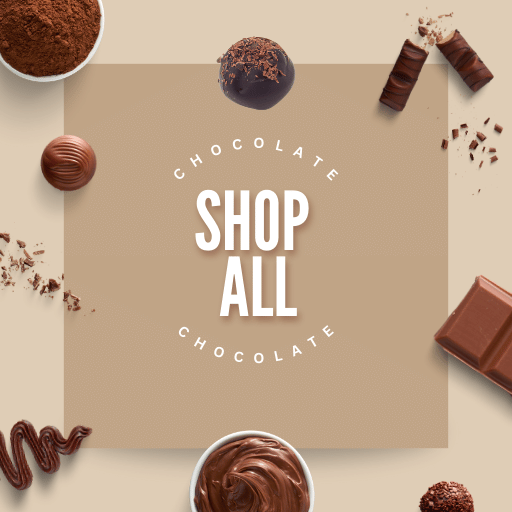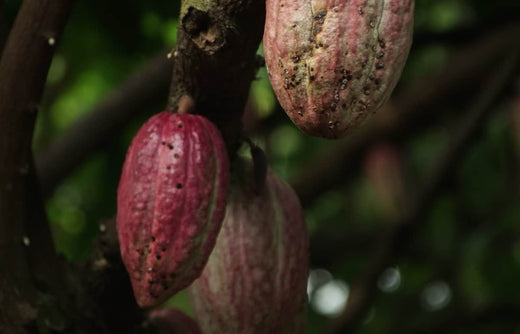Welcome to our latest indulgence, where we dive into the captivating world of chocolate and uncover the newest sensation in the realm of sweet delights: Ruby Chocolate.
This extraordinary treat has captured the hearts and taste buds of chocolate enthusiasts worldwide, and we couldn't be more excited to introduce you to its distinctive taste and the story behind its discovery.
In this blog post, we'll explore the unique qualities that set Ruby Chocolate apart from its counterparts, unveil the fascinating journey from bean to bar, and reveal how this captivating confection has earned its place among the classics of dark, milk, and white chocolate.
So join us as we embark on a sensory adventure into the enchanting world of Ruby Chocolate – a delightful experience that promises to leave you yearning for more.
What Is Ruby Chocolate?
Ruby chocolate is a type of chocolate made from ruby cocoa beans, characterised by its natural pink colour and unique fruity flavour with a hint of tanginess. It is considered the fourth type of chocolate, alongside dark, milk, and white chocolate.
What Does Ruby Chocolate Taste Like?
Ruby chocolate has a distinctive fruity flavour with a hint of tanginess, a creamy texture, and a natural pink colour, setting it apart from dark, milk, and white chocolate.
(You might also like to read this post asking: What is Blonde Chocolate?)
Why Don’t Whitakers Make Ruby Chocolate?
We choose not to produce ruby chocolate for various reasons:
-
Market demand: We focus on our popular products, such as dark, milk, and white chocolate, due to higher consumer demand for these traditional varieties.
-
Production costs and availability: Ruby chocolate requires sourcing ruby cocoa beans, which are expensive and challenging to obtain. Whitakers prioritise ingredients that are more readily available and cost-effective to maintain competitive pricing.
-
Brand identity and product range: Whitaker's wants to maintain a specific brand identity & focus on our existing product range without expanding into new categories like ruby chocolate.
-
Production capacity: Our company has limitations in production capacity or resources, leading us to prioritise our existing products over the development of new ones.
It's essential to note that companies like us continuously evaluate their product offerings based on market trends, consumer preferences, and internal factors.
Our decision not to produce ruby chocolate at present may change in the future depending on market developments and demand.
Let’s wait and see!
In the meantime, we’ve got a huge range of milk, dark and white chocolate goodies to keep you all happy and satisfied.
Here are just a few of our most popular products as voted for by you, our customers!
- Dark chocolate peppermint fondant creams
- Milk chocolate red foiled hearts
- Milk chocolate and smoky caramel squares
- Dark chocolate and ginger wafer thins
- Milk chocolate gold foiled salted caramel crisps
(You might also like to read this post asking the question: why do I crave chocolate?)
What Are the Ingredients of Ruby Chocolate?
Ruby chocolate is made from a unique set of ingredients, including:
-
Ruby cocoa beans: The primary ingredient, ruby cocoa beans, are derived from specific cocoa plants that naturally produce a distinct reddish-pink colour and fruity flavour profile.
-
Sugar: Like other types of chocolate, sugar is added to ruby chocolate to provide sweetness and balance the flavours.
-
Cocoa butter: Cocoa butter, the fat extracted from cocoa beans, is used to give ruby chocolate its smooth and creamy texture.
-
Milk powder: Milk powder is added to ruby chocolate to provide a rich and creamy taste, similar to milk chocolate.
-
Emulsifier: Typically, lecithin (usually soy lecithin) is added as an emulsifier to ensure a smooth and homogenous mixture of all ingredients, resulting in a consistent texture.
-
Natural flavourings: Some manufacturers may add natural flavourings to enhance or complement the fruity and tangy taste of ruby chocolate.
Please note that ingredients and proportions may vary between manufacturers, so it's essential to check the specific ingredient list of the ruby chocolate product you are consuming.
What is the History of Ruby Chocolate?
Ruby chocolate was introduced to the world in 2017 by Barry Callebaut, a leading chocolate and cocoa product manufacturer based in Switzerland.
The development of ruby chocolate is the result of over a decade of research and experimentation, which began in 2004.
The unique properties of ruby chocolate are attributed to the ruby cocoa beans, which are sourced from specific cocoa plants found in countries like Brazil, Ecuador, and the Ivory Coast.
These beans naturally produce a distinct reddish-pink colour and fruity flavour profile due to their unique fermentation process.
Barry Callebaut's researchers and chocolate makers perfected the processing techniques to create a new chocolate variety that retains the beans' natural colour and flavour without any added colours or artificial flavours.
The company patented their method of making ruby chocolate, and it has since gained recognition as the fourth type of chocolate, alongside dark, milk, and white chocolate.
Since its introduction, ruby chocolate has garnered significant attention and interest from consumers and chocolate makers worldwide.
Its unique appearance and taste have inspired many chocolatiers to create innovative products and confections using ruby chocolate.
(Take a look at this post if you are interested in reading about: What is cacao?)
What is the Difference Between Ruby and White Chocolate?
Ruby and white chocolate are distinct from each other in terms of their ingredients, flavour profiles, and appearance.
Here are the primary differences between the two:
-
Ingredients: The most significant difference in ingredients is the cocoa component. Ruby chocolate is made from ruby cocoa beans, which give it a unique colour and flavour. On the other hand, white chocolate does not contain cocoa solids but is made primarily from cocoa butter, sugar, and milk solids.
-
Flavour profile: Ruby chocolate has a distinctive fruity and tangy flavour, which is a result of the unique ruby cocoa beans and their specific fermentation process. White chocolate, however, has a creamy, sweet taste due to the higher amounts of sugar, cocoa butter, and milk solids.
-
Colour: Ruby chocolate has a natural reddish-pink hue, which comes from the ruby cocoa beans themselves. White chocolate has an off-white or creamy colour, which is derived from cocoa butter and milk solids.
-
Cocoa solids: White chocolate does not contain cocoa solids, which are responsible for the characteristic bitterness in dark and milk chocolate. In contrast, ruby chocolate contains a certain amount of cocoa solids, although the specific percentage may vary among manufacturers.
These differences result in unique sensory experiences when consuming ruby and white chocolate, catering to different taste preferences and offering diverse options for culinary creations.
(You might also be interested in reading this post asking: What is Compound Chocolate?)
How is Ruby Chocolate Made?
Ruby chocolate is made through a specialised process that highlights the unique colour and flavour of the ruby cocoa beans.
The steps involved in making ruby chocolate are as follows:
-
Harvesting and fermentation: Ruby cocoa beans are sourced from specific cocoa plants found in regions like Brazil, Ecuador, and the Ivory Coast. After harvesting, the beans are fermented, during which the beans develop their characteristic reddish-pink colour and fruity flavour profile.
-
Drying and roasting: The fermented beans are dried under the sun to reduce moisture content. Then, they are roasted to bring out their unique flavours while preserving the natural colour.
-
Grinding and refining: The roasted beans are ground into a fine paste which is called chocolate liquor, which contains both cocoa solids and cocoa butter. This paste is further refined to achieve a smooth texture.
-
Conching: The chocolate liquor undergoes a process called conching, where it is heated, mixed, and aerated for an extended period to develop the desired flavour and texture. During conching, sugar and milk powder are added to the mixture.
-
Tempering: The refined chocolate is then tempered by carefully raising and lowering the temperature. This controlled process results in a stable crystalline structure of the cocoa butter, ensuring a shiny appearance, smooth texture, and a satisfying snap when the chocolate is broken.
-
Moulding and cooling: The tempered ruby chocolate is poured into moulds and cooled to solidify. Once set, the chocolate is removed from the moulds and packaged for sale or used as an ingredient in various confections.
The entire process of making ruby chocolate is designed to preserve the natural colour and fruity flavour of the ruby cocoa beans while ensuring a smooth and creamy texture typical of high-quality chocolate.
Can Vegans Eat Ruby Chocolate?
Whether vegans can eat ruby chocolate depends on the specific formulation of the chocolate.
Traditional ruby chocolate contains milk powder, which is an animal-derived ingredient, making it unsuitable for vegans.
However, some chocolate manufacturers may produce vegan-friendly versions of ruby chocolate that substitute milk powder with plant-based alternatives like almond, oat, or rice milk powder.
It's essential to check the ingredients list on the packaging of the ruby chocolate product to determine if it is vegan-friendly.
Click here to discover of range of chocolate for vegans.
Why is Ruby Chocolate Pink?
Ruby chocolate is pink due to the natural colour of the ruby cocoa beans used in its production.
These beans, sourced from specific cocoa plants found in regions like Brazil, Ecuador, and the Ivory Coast, develop a reddish-pink hue during fermentation.
This unique colour is a result of the specific fermentation process and the presence of certain pigments in the beans.
The process of making ruby chocolate is designed to preserve the beans' natural colour while extracting their distinct fruity flavour.
Unlike other chocolates, ruby chocolate does not require any added colours or artificial flavours to achieve its characteristic pink hue.
The natural colour of the ruby cocoa beans is maintained throughout the production process, resulting in the visually striking and unique appearance of ruby chocolate.
Final Notes On Ruby Chocolate
Ruby chocolate has undoubtedly captured the hearts and taste buds of chocolate lovers around the world with its enchanting pink hue and distinct fruity, tangy flavour.
As the fourth type of chocolate, it has carved out a unique niche in the world of confections and paved the way for new, innovative creations by chocolatiers.
From its fascinating origins rooted in the ruby cocoa beans to the meticulous production process that retains its natural characteristics, ruby chocolate has made a lasting impact in the realm of sweet indulgences.
While it's still too early to determine if ruby chocolate will become the nation's favourite chocolate treat, its unique qualities and captivating appearance have certainly piqued the interest of many.
As we continue to explore and appreciate the diverse world of chocolate, ruby chocolate serves as a delightful reminder of the endless possibilities in taste, texture, and colour that await our discovery.
So, go ahead and treat yourself to a taste of ruby chocolate, and let it whisk you away on an unforgettable sensory adventure!











